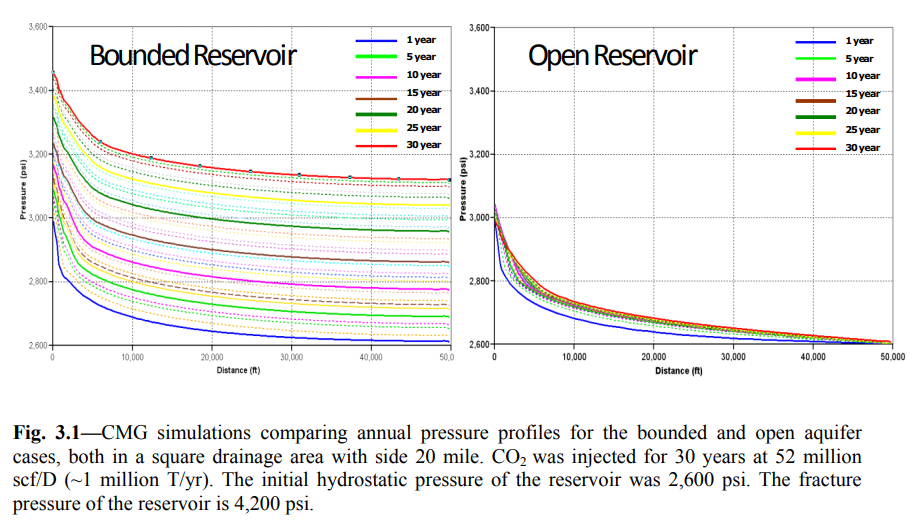AQUIFER MANAGEMENT FOR CO2 SEQUESTRATION
据IPCC估算,深层咸水层的二氧化碳储存能力高达1000亿吨。本文研究了与封闭含水层中CO2封存和含水层增压相关风险相关的问题。通过模拟分析,我们发现储存体积和所需的注入井数量超过了预期,这使得CO2地质封存成为CO2排放管理的不可行,需要采出咸水以产生亏空和降压。我们的分析模型的结果与油藏数值模拟(包括CO2封存的多相机理)非常吻合。
水层压力上升威胁到密封完整性,并构成CO2泄漏的风险。因此,监测CO2储层的长期完整性将是使地质封存成为安全、有效和可接受的温室气体控制方法的一个关键方面。开发风险评估框架需要验证受体地层中长期存在的CO2,并量化可能的CO2泄漏。讨论了CO2储层压力衰减试验,重点是储层压力监测和泄漏检测。将讨论商业封存项目定期进行压力衰减的重要性,以及这如何有助于诊断含水层泄漏。
ABSTRACT
Aquifer Management for CO2 Sequestration.
(December 2009)
Abhishek Anchliya, B.S., Indian School of Mines, Dhanbad, India
Chair of Advisory Committee: Dr. Christine Ehlig-Economides
Storage of carbon dioxide is being actively considered for the reduction of green house gases. To make an impact on the environment CO2 should be put away on the scale of gigatonnes per annum. The storage capacity of deep saline aquifers is estimated to be as high as 1,000 gigatonnes of CO2.(IPCC). Published reports on the potential for sequestration fail to address the necessity of storing CO2 in a closed system. This work addresses issues related to sequestration of CO2 in closed aquifers and the risk associated with aquifer pressurization. Through analytical modeling we show that the required volume for storage and the number of injection wells required are more than what has been envisioned, which renders geologic sequestration of CO2 a profoundly nonfeasible option for the management of CO2 emissions unless brine is produced to create voidage and pressure relief. The results from our analytical model match well with a numerical reservoir simulator including the multiphase physics of CO2 sequestration.
Rising aquifer pressurization threatens the seal integrity and poses a risk of CO2 leakage. Hence, monitoring the long-term integrity of CO2 storage reservoirs will be a critical aspect for making geologic sequestration a safe, effective and acceptable method for greenhouse gas control. Verification of long-term CO2 residence in receptor formations and quantification of possible CO2 leaks are required for developing a risk assessment framework. Important aspects of pressure falloff tests for CO2 storage reservoirs are discussed with a focus on reservoir pressure monitoring and leakage detection. The importance of taking regular pressure falloffs for a commercial sequestration project and how this can help in diagnosing an aquifer leak will be discussed.
The primary driver for leakage in bulk phase injection is the buoyancy of CO2 under typical deep reservoir conditions. Free-phase CO2 below the top seal is prone to leak if a breach happens in the top seal. Consequently, another objective of this research is to propose a way to engineer the CO2 injection system in order to accelerate CO2 dissolution and trapping. The engineered system eliminates the buoyancy-driven accumulation of free gas and avoids aquifer pressurization by producing brine out of the system. Simulations for 30 years of CO2 injection followed by 1,000 years of natural gradient show how CO2 can be securely and safely stored in a relatively smaller closed aquifer volume and with a greater storage potential. The engineered system increases CO2 dissolution and capillary trapping over what occurs under the bulk phase injection of CO2.
This thesis revolves around identification, monitoring and mitigation of the risks associated with geological CO2 sequestration.


